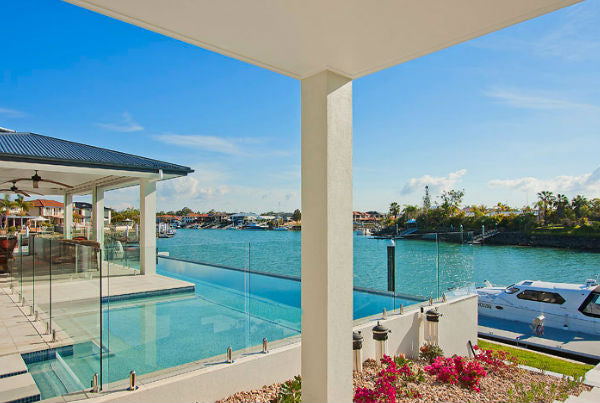How to Install Base Mounted Spigots into Concrete
Base Mounting on Concrete
In certain applications, core drilling may not be suitable or preferred way of fixing spigots on a concrete slab. For instance, if the proposed centre line of the glass panel is less than 100mm
from edge of the slab, risking cracking of the concrete; when other runs of the glass pool fence or balustrade are base mounted to timber with different looking dressing caps; if use of a water core-drilling machine is not preferred etc.
Base mount spigots have a slotted flange for fixing to concrete with Dynabolts or ChemSet anchors.
Shop Our Spigot RangeNOTE : In order to eliminate the need for electrical earthing of base mounted spigots and satisfy Building Approval criteria AS3000 on a new pool installation, ensure the spigots are MORE than 1250mm from the water's edge. If this is not possible, core drilled spigots with a conduit earth system will be required.
Before You Start
Make sure you have spigots - if you need to grab some, check out our collection here
Your Site Will Require:
- A hard, level unloading surface suitable for a pallet jack
- Sufficient access / unloading area
- Flat storage area with a clean timber pallet (or similar) and clean timber rails for separation and protection
- Mains Electricity - 240V, 10AMP
How To Set The Spigot Spacing
Follow the guide below to ensure your spigot positioning complies with TGD’s testing, AS1288 and glass panel span regulations.

| Glass panel width | Distance from panel end |
| 100-600mm* | *special installation required – please contact our office |
| 600-900mm | X = 125mm |
| 1000mm-1200mm | X = 150mm |
| 1300-1500mm | X = 200mm |
| 1500+* | X = 250mm / *special installation required – you may need 3 spigots - please contact our office |
How to Fix Round Spigots

With good quality tools, including an Allen key set, a mini-core drill machine/masonry drill set up, sockets and spanners, fit your base plated spigots as above - securing with FOUR fixings – use either the in-line (L) or diagonal (D) slots.

How to Fix Square Spigots
Using the same method, square spigots are secured by only FOUR fixing that are in-line as shown below with ‘L’. The nuts of your Dyna Bolts or ChemSet anchors will foul and damage the spigot if the slots are used.
Dynabolt Anchoring Using a Masonry Drill

NOTES:
- Dynabolts are inserted first and the spigot place over the protruding threads
- Round or square spigots can be fixed by either all FOUR holes or all FOUR slots since the protruding threads and nuts are smaller than that of coach screws
- TGD’s recommended M10 stainless steel 316 Dynabolts are 75mm in length – longer ones will be required to offset any tile or paver thickness on the slab, e.g. 40mm paver = 120mm Dynabolt
- Ensure the closest proposed hole is at least 80mm from the edge – any less would run the risk of cracking the edge of the slab, making ChemSet fixing necessary
CAUTION! Consult your hardware supplier for the correct masonry drill. Failure to do so could result in a loose fixation
FITMENT:
- Mark out as per the main guide and, using a masonry drill set up, drill to a depth of 90mm
- Clear the holes of debris
- Insert and fit your Dynabolt as per manufacturer’s instructions, leaving approx. 13mm of thread protruding
- Remove the nuts and washers and place the spigot over the 4 threads
- Nip up the spigots, adjusting for alignment and squareness as required
- Using a ring spanner, tighten the spigot down and again check for square and alignment
- Fit the dress rings and glass panels – DO NOT force panels into place, check and adjust the spigots as needed
TIP : Do the final tightening only when you are satisfied with all alignment and levels – packing and shimming of the spigots will likely be required in most instances
Shop Our Spigot RangeChemSet Anchoring Using a Masonry Drill

NOTES:
- ChemSet threaded studs or TGD’s stainless steel threaded rods are fitted first in the holes and the spigot then place over the protruding threads
- Round or square spigots can be fixed by either all FOUR holes or all FOUR slots since the protruding threads and nuts are smaller than that of coach screws
- TGD-supplied and recommended M10 316 stainless steel threaded rods are 100mm in length in order to ensure a minimum anchoring depth of 75mm is achieved - longer lengths of threaded rod or ChemSet anchors will be required to offset any tile or paver thickness on the slab, e.g. 40mm paver = 120mm threaded rod / ChemSet anchor
- Ensure the closest proposed hole is at least 65mm from the edge - any less would run the risk of cracking the edge of the slab cracking the edge of the slab
CAUTION! Consult your hardware supplier for the correct masonry drill and ChemSet adhesive
FITMENT:
- Drill to a depth of approx. 90mm
- Clear the hole of debris
- Following the manufacturer’s instructions for applying the adhesive first, then insert your ChemSet stud or TGD threaded rod, leaving approx. 13mm of thread protruding
- When cured, place the spigot over the 4 threads and add the nuts and washers
- Nip up the spigots, adjusting for alignment and squareness as required
- Using a ring spanner, tighten the spigot down and again check for square and alignment
- Fit the dress rings and glass panels – DO NOT force panels into place, check and adjust the spigots as needed
TIP: Carry out the final tightening only when you are satisfied with all alignment and levels – packing and shimming of the spigots will likely be required in most instances
Marking Out
Using a string-line, mark the centre of each run and where the spigots will intersect, not forgetting to also mark out where the glass panels and each gap panel will fall.

Use one of the spigots and a permanent marker to plan out the glass panel runs with their gaps and mark where the base plate should go, and where the fixing points need to be. Double check all your dimensions are correct before proceeding.
ChemSet & Dynabolt Anchoring Using a Mini-Core Drill
If there is a risk of surface finish damage or tile breakage by using a masonry drill, a mini-core drill and bit can be used to create the required spigot holes.
Alternative Tools Required:
- Coring machine and mini-corer bit x 10mm dia.
- Mains pressure water, bucket and sponge
CAUTION! Consult your hardware supplier about the correct diameter mini-core drill bit for your chosen method of fixing.
- Set out
- Create a temporary core-drill guide from a piece or 12mm plywood or similar. This will serve as a ‘steady’ and prevent the mini-core drill bit ‘wandering off’ since it has no starting centre point
- Use the mini-core drilling machine with appropriate diameter bit to cut through the ceramic tiles or surface at your 4 positions per mount using a gentle motion and light pressure. Wash off the slurry before it dries and stains

- On an uneven or coarse surface, squares of rubber may be drilled and fitted under the spigot and trimmed after install with a Stanley blade or similar

- Fit the dress rings
- Use the 'buddy system' to fit your glass panels and gate if require – DO NOT force panels into place, check and adjust the spigots as needed. Some adjustment with packers or shims may be necessary – refer to our ‘How to Pack and Shim' guide

- Fit the handrail as required by referring to TGD’s ‘Handrail Installation' guide
Need to Buy Base Mounted Spigots?
Need some extra base mounted spigots to finish off the last steps of your glass fence installation? Check out our Spigots collection page for all your needs! We also provide other forms of spigots and hardware that might help out your glass fencing situation.
Shop Our Spigot Range

